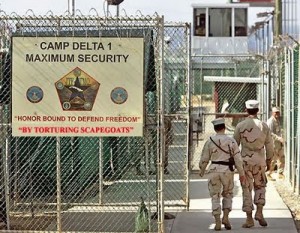Reflection: The American Dream in Action
National Dialogue and Traveling Exhibit | Reflection + Action
After reading all of the articles provided at the Guantánamo Public Memory Project website, seeing all the images and hearing all of the testimonies, I feel so entrenched in the site and its situation that I want to take the next personnel flight back stateside. Just like many others who visit, part of me remains numbed by the constant mainstream horror stories that have surrounded Guantánamo, and some of the inherent shock value tends to get lost. You say many detainees remain incarcerated here without due process, devoid of human rights? Well, yes, I know, I’ve heard it many times. I have heard about it, and it should leave me shocked and appalled, but it doesn’t. The numb reaction leaves me sick, rather than the facts themselves.
Then I found Andy Urban’s article on immigrant detention centers in New Jersey. It read like a paper from the immediate post-9/11 years, about 2002-2004, when anti-Arab and Muslim fear were in full swing. Then the author described the “Voices of the Disappeared” report from 2007. A more bone-chilling title could not have been chosen. It took me back to the first time I learned of “Los Desaparecidos”, the countless centerpieces of the Memoria Abierta project. People have and still can disappear, and they can disappear here. In Jersey. Aha, there’s the nauseated feeling I’ve been praying for.
Let me be the umpteenth person to say it: the detention center at Guantánamo should be closed. For two legitimate reasons. First, if sites such as the detention center of the Hudson County Jail can and do exist within the U.S. without general public knowledge of it, then Guantánamo’s detention purpose becomes redundant. Second, the use of this site violates everything this country claims to stand for: violation of personal freedoms in favor of “security.” It demonstrates how lazy and self centered the American people are, given that they will allow their God-given rights to be taken away, just as long as we all stay comfortable.
There are many reasons. So many more reasons; but even if the War on Terror were to end tomorrow, the Guantánamo facilities would remain in use in one form or another. Just as virtually every article pointed out, it’s a political “black hole”, where only the golden rule of Vegas applies. The sad thing is, this situation offers just as many positive opportunities. As the testimony of Pavel Rodriguez and other refugee stories prove, this site could still provide both safe refuge and a stepping stone for those seeking a new American life. Instead, it’s a place where the man in charge can do whatever he wants, however he wants, to whomever he wants. The American dream in action.
By Ryan Hatch, Public History Program, Arizona State University
Ryan Hatch participated in a course titled “Shaping Public History’s role in Human Rights: Sites of Conscience and the Guantánamo Public Memory Project,” as part of Arizona State University’s Public History Program.
Arizona State University is participating in the Guantánamo Public Memory Project‘s National Dialogue and Traveling Exhibit. Opening at NYU’s Kimmel Center for University Life Windows Gallery in December 2012 and traveling to 9 sites (and counting) across the country through at least 2014, the exhibit will explore GTMO’s history from US occupation in 1898 to today’s debates and visions for its future. The exhibit is being developed through a unique collaboration among a growing number of universities as a dialogue among their students, communities, and people with first-hand experience at GTMO.

